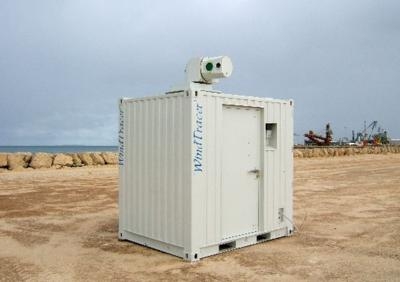Mon, Feb 18, 2013
Lidar Measurements Led To Reduction In Diagonal Spacing On Adjacent Runways
The FAA has applied hundreds of thousands of research measurements made by Lockheed Martin's WindTracer Doppler lidar to redefine flight rules, achieving major efficiency enhancements at U.S. airports.

The FAA granted approval for San Francisco International Airport (SFO) and Newark Liberty International Airport (EWR) to conduct dependent arrival operations on their closely spaced parallel runway (CSPR) pairs. SFO and EWR have joined a growing list of airports with CSPR geometries that are authorized by the Federal Aviation Administration to conduct a wake turbulence mitigation procedure for CSPR operation, known as FAA Order JO 7110.308 – Ch3. The safety assessment is enabled with significant amount of wake measurement research using WindTracer lidars.
The assessment permits reduced diagonal spacing of 1.5 nautical miles on adjacent runways relative to the leading large- and small-category aircraft with runway spacing less than 2500 feet under Instrument Flight Rules. Before the implementation of 7110.308, planes arriving on two such CSPRs were required to be spaced as if they were using a single runway, which effectively closed down one of the parallel runways under instrument conditions. This procedure at SFO and EWR is expected to reduce delays significantly.
"We are thrilled that the FAA has employed our WindTracer Doppler lidars to achieve these critical improvements to U.S. air traffic rules," said Dr. Michael Margulis, director of WindTracer Programs at Lockheed Martin. "These changes will greatly increase U.S. civil airspace capacity while maintaining the highest standards of air traffic safety."
The FAA Wake Turbulence Research Program has been using WindTracer systems since 2001 at multiple airport locations to conduct wake turbulence research measurements. The databases are carefully mined to provide data-driven assessment of ongoing and future wake turbulence mitigation concepts. In addition, wind data collection is also used to develop weather-based wake mitigation solutions.
The John A. Volpe National Transportation Systems Center, part of the U.S. Department of Transportation's Research and Innovative Technology Administration, maintains and operates a fleet of WindTracers for the FAA Wake Turbulence Research Program and provides data analysis and other resource supports.
(WindTracer image courtesy Lockheed Martin)
More News
A Puff Of Smoke Came Out From The Top Of The Engine Cowling Followed By A Total Loss Of Engine Power On May 9, 2025, about 1020 mountain daylight time, an experimental amateur-buil>[...]
From 2022 (YouTube Edition): Jenny, I’ve Got Your Number... Among the magnificent antique aircraft on display at EAA’s AirVenture 2022 was a 1918 Curtiss Jenny painstak>[...]
Very High Frequency (VHF) The frequency band between 30 and 300 MHz. Portions of this band, 108 to 118 MHz, are used for certain NAVAIDs; 118 to 136 MHz are used for civil air/grou>[...]
“From approximately November 2021 through January 2022, Britton-Harr, acting on behalf of AeroVanti, entered into lease-purchase agreements for five Piaggio-manufactured airc>[...]
From 2008 (YouTube Edition): US Fish and Wildlife Service Chooses The Kodiak To Monitor Waterfowl Populations Waterfowl all over North America may soon have to get used to a new ab>[...]
 NTSB Prelim: Lee Aviation LLC JA30 SuperStol
NTSB Prelim: Lee Aviation LLC JA30 SuperStol Classic Aero-TV: Curtiss Jenny Build Wows AirVenture Crowds
Classic Aero-TV: Curtiss Jenny Build Wows AirVenture Crowds ANN's Daily Aero-Term (05.30.25): Very High Frequency (VHF)
ANN's Daily Aero-Term (05.30.25): Very High Frequency (VHF) Aero-News: Quote of the Day (05.30.25)
Aero-News: Quote of the Day (05.30.25) Classic Aero-TV: Quest Kodiak Enhances Migration Monitoring Programs
Classic Aero-TV: Quest Kodiak Enhances Migration Monitoring Programs



